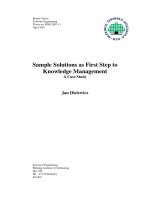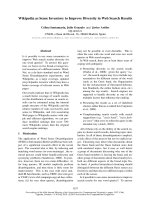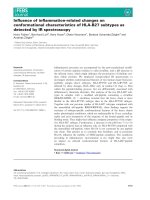IARC CLASSIFIES RADIOFREQUENCY ELECTROMAGNETIC FIELDS AS POSSIBLY CARCINOGENIC TO HUMANS potx
Bạn đang xem bản rút gọn của tài liệu. Xem và tải ngay bản đầy đủ của tài liệu tại đây (250.51 KB, 6 trang )
PRESS RELEASE
N° 208
31 May 2011
IARC CLASSIFIES RADIOFREQUENCY ELECTROMAGNETIC FIELDS AS
POSSIBLY CARCINOGENIC TO HUMANS
Lyon,France,May31,2011‐‐TheWHO/InternationalAgencyforResearchonCancer(IARC)has
classifiedradiofrequencyelectromagneticfieldsaspossiblycarcinogenictohumans(Group2B),
based on an increased risk for glioma, a malignant type of brain cancer
1
, associated with
wirelessphoneuse.
Background
Over the last few years, there has been mounting concern about the possibility of adverse
health effectsresultingfromexposuretoradiofrequencyelectromagneticfields,suchasthose
emitted by wireless communication devices. The number of mobile phone subscriptions is
estimatedat5billionglobally.
FromMay24–312011,aWorkingGroupof31scientistsfrom14countrieshasbeenmeeting
at IARC in Lyon, France, to assess the potential carcinogenic hazards from exposure to
radiofrequencyelectromagneticfields.TheseassessmentswillbepublishedasVolume102of
theIARCMonographs,whichwillbethefifthvolumeinthisseriesto focusonphysicalagents,
after Volume 55 (Solar Radiation), Volume 75 and Volume 78 on ionizing radiation (X‐rays,
gamma‐rays, neutrons, radio‐nuclides), and Volume 80 on non‐ionizing radiation (extremely
low‐frequencyelectromagneticfields).
The IARC Monograph Working Group discussed the possibility that these exposures might
inducelong‐termhealtheffects,inparticularanincreasedriskforcancer.Thishasrelevancefor
public health, particularly for users of mobile phones, as the number of users is large and
growing,particularlyamongyoungadultsandchildren.
The IARC Monograph Working Group discussed and evaluated the available literature on the
followingexposurecategoriesinvolvingradiofrequencyelectromagneticfields:
¾ occupationalexposurestoradarandtomicrowaves;
¾ environmentalexposuresassociatedwithtransmissionofsignalsforradio,televisionand
wirelesstelecommunication;and
¾ personalexposuresassociatedwiththeuseofwirelesstelephones.
International experts shared the complex task of tackling the exposure data, the studies of
cancer in humans
, the studies of cancer in experimental animals, and the mechanistic and
otherrelevantdata
.
1
237913newcasesofbraincancers(alltypescombined)occurredaroundtheworldin2008(gliomasrepresent
2/3ofthese).Source:
Globocan2008
Page 2
IARC CLASSIFIES RADIOFREQUENCY ELECTROMAGNETIC FIELDS AS
POSSIBLY CARCINOGENIC TO HUMANS
IARC, 150 Cours Albert Thomas, 69372 Lyon CEDEX 08, France - Tel: +33 (0)4 72 73 84 85 - Fax: +33 (0)4 72 73 85 75
© IARC 2011 - All Rights Reserved.
Results
The evidence was reviewed critically, and overall evaluated as being limited
2
among users of
wirelesstelephonesforgliomaandacousticneuroma,andinadequate
3
todrawconclusionsfor
other types of cancers. The evidence from the occupational and environmental exposures
mentioned above was similarly judged inadequate.The Working Group did notquantitate the
risk;however,onestudyofpastcellphoneuse(uptotheyear2004),showeda40%increased
risk for gliomas in the highest category of heavy users (reportedaverage: 30 minutes per day
overa10‐yearperiod).
Conclusions
Dr Jonathan Samet (University of Southern California, USA), overall Chairman of the Working
Group, indicated that "the evidence, while still accumulating, is strong enough to support a
conclusion andthe2Bclassification.Theconclusionmeansthattherecouldbesomerisk,and
thereforeweneedtokeepaclosewatchforalinkbetweencellphonesandcancerrisk."
"Giventhepotentialconsequencesforpublichealthofthisclassificationandfindings,"saidIARC
DirectorChristopherWild,"itisimportantthatadditionalresearchbeconductedintothelong‐
term,heavyuseofmobilephones.Pendingtheavailabilityofsuch information,itis important
totakepragmaticmeasurestoreduceexposuresuchashands‐freedevicesortexting."
TheWorkingGroupconsideredhundredsofscientificarticles;thecompletelistwillbepublished
in the Monograph. It is noteworthy to mention that several recent in‐press scientific articles
4
resultingfromtheInterphonestudyweremadeavailabletotheworkinggroupshortlybeforeit
wasduetoconvene,reflectingtheiracceptanceforpublicationatthattime,andwereincluded
intheevaluation.
A concise report summarizing the main conclusions of the IARC Working Group and the
evaluations of the carcinogenic hazard from radiofrequency electromagnetic fields (including
theuseofmobiletelephones)willbepublishedinTheLancetOncologyinitsJuly1issue,andin
afewdaysonline.
2
'Limitedevidence of carcinogenicity': Apositiveassociation hasbeenobserved betweenexposure totheagent
andcancerforwhichacausalinterpretationisconsideredbytheWorkingGrouptobecredible,butchance,biasor
confoundingcouldnotberuledoutwithreasonableconfidence.
3
'Inadequateevidenceofcarcinogenicity':Theavailablestudiesareofinsufficientquality,consistencyorstatistical
power to permit a conclusion regarding the presence or absence of a causal association between exposure and
cancer,ornodataoncancerinhumansareavailable.
4
a. 'Acoustic neuroma risk in relation to mobile telephone use: results of the INTERPHONE international case‐
controlstudy'(theInterphoneStudyGroup,inCancerEpidemiology,inpress)
b. 'Estimation of RF energy absorbed in the brain from mobile phones in the Interphone study' (Cardis et al.,
OccupationalandEnvironmentalMedicine,inpress)
c. 'Risk of brain tumours in relation to estimated RF dose from mobile phones – results from five Interphone
countries'(Cardisetal.,OccupationalandEnvironmentalMedicine,inpress)
d.'LocationofGliomasinRelationtoMobileTelephoneUse:ACase‐CaseandCase‐SpecularAnalysis'(American
JournalofEpidemiology,May24,2011.[Epubaheadofprint].
Page 3
IARC CLASSIFIES RADIOFREQUENCY ELECTROMAGNETIC FIELDS AS
POSSIBLY CARCINOGENIC TO HUMANS
Formoreinformation,pleasecontact
DrKurtStraif,IARCMonographsSection,at+33472738511,or;DrRobertBaan,
IARCMonographsSection,at+33472738659,or;orNicolasGaudin,IARC
CommunicationsGroup,at(+33472738478)
Linktotheaudiofilepostedshortlyafterthebriefing:
/>
AboutIARC
The International Agency for Research on Cancer (IARC) is part of the World Health
Organization.Itsmissionistocoordinateandconductresearchonthecausesofhumancancer,
the mechanisms of carcinogenesis, and to develop scientific strategies for cancer control. The
Agencyisinvolvedinbothepidemiologicalandlaboratoryresearchanddisseminatesscientific
informationthroughpublications,meetings,courses,andfellowships.
If you wish your name to be removed from our press release e‐mailing list, please write to
NicolasGaudin,Ph.D.
Head,IARCCommunications
InternationalAgencyforResearchonCancer
WorldHealthOrganization
150,coursAlbert‐Thomas
69008Lyon
France
Email
/>
IARC, 150 Cours Albert Thomas, 69372 Lyon CEDEX 08, France - Tel: +33 (0)4 72 73 84 85 - Fax: +33 (0)4 72 73 85 75
© IARC 2011 - All Rights Reserved.
Page 4
IARC CLASSIFIES RADIOFREQUENCY ELECTROMAGNETIC FIELDS AS
POSSIBLY CARCINOGENIC TO HUMANS
IARC, 150 Cours Albert Thomas, 69372 Lyon CEDEX 08, France - Tel: +33 (0)4 72 73 84 85 - Fax: +33 (0)4 72 73 85 75
© IARC 2011 - All Rights Reserved.
ABOUTTHEIARCMONOGRAPHS
WhataretheIARCMonographs?
The IARC Monographs identify environmental factors that can increase the risk of human
cancer. These include chemicals, complex mixtures, occupational exposures, physical and
biologicalagents,andlifestylefactors.Nationalhealthagenciesusethisinformationasscientific
supportfortheiractionstopreventexposuretopotentialcarcinogens.Interdisciplinaryworking
groupsofexpertscientistsreviewthepublishedstudiesandevaluatetheweightoftheevidence
that anagentcanincrease theriskofcancer.The principles, procedures, andscientificcriteria
thatguidetheevaluationsaredescribedinthePreambletotheIARCMonographs.
Since1971,morethan900agentshavebeenevaluated,ofwhichapproximately400havebeen
identifiedascarcinogenicorpotentiallycarcinogenictohumans.
Definitions
Group1:Theagentiscarcinogenictohumans.
This category is used when there is sufficient evidence of carcinogenicity in humans.
Exceptionally, an agent may be placed in this category when evidence of carcinogenicity in
humansislessthansufficientbutthereissufficientevidenceofcarcinogenicityinexperimental
animals and strong evidence in exposed humans that the agent acts through a relevant
mechanismofcarcinogenicity.
Group2.
This category includes agents for which, at one extreme, the degree of evidence of
carcinogenicityinhumansisalmostsufficient,aswellasthoseforwhich,attheotherextreme,
there are no human data but for which there is evidence of carcinogenicity in experimental
animals.AgentsareassignedtoeitherGroup2A(probablycarcinogenictohumans)orGroup2B
(possiblycarcinogenictohumans)onthebasisofepidemiologicalandexperimentalevidenceof
carcinogenicity and mechanistic and other relevantdata.Thetermsprobablycarcinogenicand
possibly carcinogenic have no quantitative significance and are used simply as descriptors of
different levels of evidence of human carcinogenicity, with probably carcinogenic signifying a
higherlevelofevidencethanpossiblycarcinogenic.
Group2A:Theagentisprobablycarcinogenictohumans.
Thiscategoryisusedwhenthereislimitedevidenceofcarcinogenicityinhumansandsufficient
evidenceofcarcinogenicityinexperimentalanimals.Insomecases,anagentmaybeclassifiedin
this category when there is inadequate evidence of carcinogenicity in humans and sufficient
evidenceofcarcinogenicityinexperimentalanimalsandstrongevidencethatthecarcinogenesis
is mediated by a mechanism that also operates in humans. Exceptionally, an agent may be
classifiedinthiscategorysolelyonthebasisoflimitedevidenceofcarcinogenicityinhumans.An
agent may be assigned to this category if it clearly belongs, based on mechanistic
considerations, to a class of agents for which one or more members have been classified in
Group1orGroup2A.
Page 5
IARC CLASSIFIES RADIOFREQUENCY ELECTROMAGNETIC FIELDS AS
POSSIBLY CARCINOGENIC TO HUMANS
IARC, 150 Cours Albert Thomas, 69372 Lyon CEDEX 08, France - Tel: +33 (0)4 72 73 84 85 - Fax: +33 (0)4 72 73 85 75
© IARC 2011 - All Rights Reserved.
Group2B:Theagentispossiblycarcinogenictohumans.
Thiscategoryisusedforagentsforwhichthereislimitedevidenceofcarcinogenicityinhumans
andlessthansufficientevidenceofcarcinogenicityinexperimentalanimals.Itmayalsobeused
whenthereisinadequateevidenceofcarcinogenicityinhumansbutthereissufficientevidence
of carcinogenicity in experimental animals. In some instances, an agent for which there is
inadequate evidence of carcinogenicity in humans and less than sufficient evidence of
carcinogenicity in experimental animals together with supporting evidence from mechanistic
andotherrelevantdatamaybeplacedinthisgroup.Anagentmaybeclassifiedinthiscategory
solelyonthebasisofstrongevidencefrommechanisticandotherrelevantdata.
Group3:Theagentisnotclassifiableastoitscarcinogenicitytohumans.
This category is used most commonly for agents for which the evidence of carcinogenicity is
inadequateinhumansandinadequateorlimitedinexperimentalanimals.
Exceptionally, agents for which the evidence of carcinogenicity is inadequate in humans but
sufficientinexperimentalanimalsmaybeplacedinthiscategorywhenthereisstrongevidence
thatthemechanismofcarcinogenicityinexperimentalanimalsdoesnotoperateinhumans.
Agentsthatdonotfallintoanyothergrouparealsoplacedinthiscategory.
AnevaluationinGroup3isnotadeterminationofnon‐carcinogenicityoroverallsafety.Itoften
meansthatfurtherresearchisneeded,especiallywhenexposuresarewidespreadorthecancer
dataareconsistentwithdifferinginterpretations.
Group4:Theagentisprobablynotcarcinogenictohumans.
Thiscategoryisusedforagentsforwhichthereisevidencesuggestinglackofcarcinogenicityin
humans and in experimental animals. In some instances, agentsfor which there is inadequate
evidence of carcinogenicity in humans but evidence suggesting lack of carcinogenicity in
experimentalanimals,consistentlyandstronglysupportedbyabroadrangeofmechanistic and
otherrelevantdata,maybeclassifiedinthisgroup.
Definitionsofevidence,asusedinIARCMonographsforstudiesinhumans
The evidence relevant to carcinogenicity from studies in humans is classified into one of the
followingcategories:
Sufficientevidenceofcarcinogenicity: The Working Group considers that acausalrelationship
has been established between exposure to the agent and human cancer. That is, a positive
relationship has been observed between the exposure and cancer in studies in which chance,
biasandconfoundingcouldberuledoutwithreasonableconfidence.Astatementthatthereis
sufficient evidence is followed by a separate sentence that identifies the target organ(s) or
tissue(s)whereanincreasedriskofcancerwasobservedinhumans.Identificationofaspecific
targetorganortissuedoesnotprecludethepossibilitythattheagentmaycausecanceratother
sites.
Page 6
IARC CLASSIFIES RADIOFREQUENCY ELECTROMAGNETIC FIELDS AS
POSSIBLY CARCINOGENIC TO HUMANS
IARC, 150 Cours Albert Thomas, 69372 Lyon CEDEX 08, France - Tel: +33 (0)4 72 73 84 85 - Fax: +33 (0)4 72 73 85 75
© IARC 2011 - All Rights Reserved.
Limited evidence of carcinogenicity: A positive association has been observed between
exposuretotheagentandcancerforwhichacausalinterpretation isconsideredbytheWorking
Group to be credible, but chance,biasor confounding could not be ruled out with reasonable
confidence.
Inadequate evidence of carcinogenicity: The available studies are of insufficient quality,
consistencyorstatisticalpowertopermita conclusion regardingthepresenceorabsenceofa
causalassociationbetweenexposureandcancer,ornodataoncancerinhumansareavailable.
Evidence suggesting lack of carcinogenicity: There are several adequate studies covering the
full range of levels of exposure that humans are known to encounter, which are mutually
consistentinnotshowingapositiveassociationbetweenexposuretotheagentandanystudied
cancer at any observed level of exposure. The results from these studies alone or combined
should have narrow confidence intervals with an upper limit close to the null value (e.g. a
relativeriskof1.0).Biasandconfoundingshouldberuledoutwithreasonableconfidence,and
the studies should havean adequate length of follow‐up. A conclusion ofevidence suggesting
lackofcarcinogenicityisinevitablylimitedtothecancersites,conditionsandlevelsofexposure,
andlengthofobservationcoveredbytheavailablestudies.Inaddition,thepossibilityofavery
smallriskatthelevelsofexposurestudiedcanneverbeexcluded.
Insomeinstances,theabove categoriesmaybeusedtoclassifythedegreeofevidencerelated
tocarcinogenicityinspecificorgansortissues.









